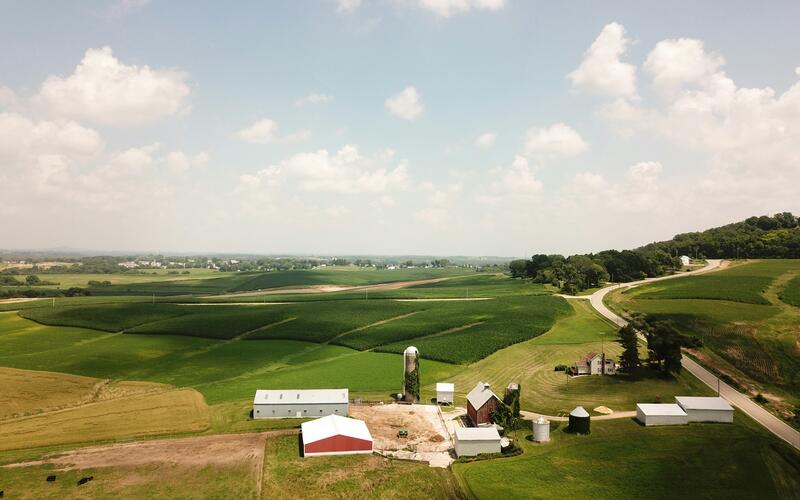Lessons from Rural Elders: Re-imagining the food system means a return to relationships

Lessons from Rural Elders: Re-imagining the food system means a return to relationships
Rural communities are essential to food production in the United States. Despite this, they rarely receive the benefits of this food commensurate with their investments in this system. Elders in rural communities are incredibly overlooked in food access interventions and consistently benefit the least from the food they help grow. This oversight makes rural elders particularly vulnerable to food insecurity. The current food system disconnects elders from the food grown in their communities and, therefore, must be transformed to prioritize care for these vulnerable populations.
Giroux, S., Waldman, K., Burris, M., Valliant, J. C. D., Babb, A. M., Stafford, P., Fobi, D., Czebotar, K., & Knudsen, D. C. (2022). Food security and well-being among older, rural Americans before and during the COVID-19 pandemic. PLOS ONE, 17(9), e0274020. https://doi.org/10.1371/journal.pone.0274020
Kent, K., Alston, L., Murray, S., Honeychurch, B., & Visentin, D. (2022). The Impact of the COVID-19 Pandemic on Rural Food Security in High Income Countries: A Systematic Literature Review. International Journal of Environmental Research and Public Health, 19(6), Article 6. https://doi.org/10.3390/ijerph19063235
Quandt, S. A., Arcury, T. A., McDonald, J., Bell, R. A., & Vitolins, M. Z. (2001). Meaning and Management of Food Security Among Rural Elders. Journal of Applied Gerontology, 20(3), 356–376. https://doi.org/10.1177/073346480102000307
Today’s industrialized food systems bring food from rural and agricultural communities to dining tables throughout the United States (U.S.). The benefits from industrialization, however, will only be worthwhile if rural elders have access to food, especially food produced by their communities. Food insecurity is a complex issue facing the entirety of the U.S. Because of the intersectional and complex levels of food insecurity, researchers, policymakers, and advocates are pulled in different directions when considering hunger solutions. Since food insecurity in rural contexts intersects with poverty, it receives even less attention. The pandemic intensified supply-chain issues for food products enough to bring rural food insecurity into the public consciousness. This near collapse of the supply chain unexpectedly revived an examination of food access issues in rural communities. Despite this renewed interest, rural elders must be visible in U.S. industrialized food system analyses.
Rural communities in the United States produce significant amounts of food for the country and exportation. The Food Research & Action Center and Feeding America both contend that despite this critical role, rural communities need access to enough food to feed themselves. Even more concerning, rural communities face higher rates of food insecurity compared to their urban counterparts.
The food system neglecting rural society is the same one excluding Native, Black, and Latinx farmers and farmworkers from the American food system. The United States agricultural network has also led to the systematized diminishment and replacement of small-scale and large industrial farms. These industrial farms generate more than half of the revenue from agricultural production in the United States. Although the U.S. processes, exports, and profits from massive food production, this current agrarian structure has created a significant division between people and their food. This divide and lack of relationality have weakened rural food systems, thus leaving rural elders especially vulnerable to food insecurity.
A Look into Rural Elder’s Food Security in North Carolina
In 2001, a study conducted by Sara Quandt and her colleagues sought to understand how North Carolina adults, 70 years and older, experience and manage food security. Their research demonstrated that factors like age-related nutritional deficiencies, higher food costs, and limited food selection make rural elders in the U.S. highly vulnerable to hunger. Because food access and health are interconnected, food insecurity also makes elders more likely to face poverty and poor health.
Quandt and her team interviewed 145 African American, European American, and Native-American seniors. The interviews allowed the researchers to center community voices and relationships. The researchers learned that rural elders utilized grass-roots mutual aid systems to access food even when the industrial food system failed them. Regardless of ethnic group or gender, almost everyone in the study shared the same perspective on the nature of food security. “You can’t always get what you want,” the elders would say, almost word-for-word, in their interviews. However, access to their desired foods continued for rural elders to create alternative pathways to food security in their community.
Instead of being paralyzed by the systemic failures of the food system, elders viewed the lack of food as a natural part of the ebbs and flows in rural seasons. Accustomed to these abundant and lean times patterns, elders stored large amounts of food using a freezer or pantry to prepare for times with limited access to culturally desirable foods. Elders also reported trust and reliance on their community, citing family, friends, and neighbors to care for them when they expressed a need. These results shed light on how rural elders perceive food insecurity and have adapted to it as a natural part of rural living. Furthermore, this research demonstrates how essential community networks are to sustaining food security in lean times.
Quandt and her team emphasized the importance of understanding rural values when figuring out solutions for food insecurity, especially the value of community. Elders took pride in self-sufficiency and relied on informal support from family, friends, and community members. More importantly, they needed more formalized support for food. The elders disliked interventions that forced them to depend on welfare and credit. For African American and Native American elders, this distrust of government support was based on past histories of disenfranchisement. Considering their findings, the researchers recommended alternatives to welfare or credit-based systems to mitigate the impacts of food insecurity. Instead, the researchers suggested community-based solutions consistent with the values held by rural elders, such as food gifts, congregate meals, and surplus distribution. Rural elders not only consistently saw these solutions as acceptable but also as symbols of a strong community.
This study highlighted how rural elders saw the community as a source of food security and trusted that their relational networks would sustain them in difficult times. This research, therefore, urged readers to take rural elders’ food security seriously and to respect the community-based solutions they created for themselves before offering top-down solutions. The researchers affirmed the crucial role of rural elders in sustaining the more extensive U.S. food system, holding together mutual aid networks in an expansive agricultural landscape.
National and Global Perspectives on Pandemic Impacts on Rural Food Security
In 2020, almost two decades after Quandt’s article was published, the COVID-19 pandemic swept the globe. The pandemic revealed weaknesses in international and domestic supply chains, including U.S. food systems. Katherine Kent and her team of researchers were interested in how the pandemic might impact rural food systems. To explore this, they conducted a high-level systematic literature review on pandemic impacts on rural food security in high-income countries. While the researchers included studies conducted in Chile, Australia, Canada, Germany, Israel, and the United Kingdom, more than half of the literature reviewed occurred in the United States.
Ultimately, Kent and her team found that the pandemic has exacerbated food security issues in rural communities and deepened rural/urban inequalities. According to the researchers, the pandemic was more impactful in rural areas in high-income countries precisely because rural communities tend to have higher percentages of aging populations.
Additionally, rural food systems were purposefully deprioritized during the pandemic. Before the pandemic, rural communities struggled with inadequate supermarkets and geographical barriers affecting food supply. During the pandemic, supermarkets consistently supplied large metro areas with food before considering rural areas. Oversights like this in the pandemic led to even less food availability in rural communities in high-income countries, further intensified by fewer open shops and increased food prices.
Despite this, a few studies showcased rural food systems that were even more resilient to pandemic impacts than their urban counterparts. A study in Michigan showed that rural farmers in Michigan maintained their profit, workers, and customers. In Franklin County, Ohio, a study found that rural grocery stores did not experience a significant decrease in traffic during the lockdown and reopening phases of the pandemic. Lastly, a large-scale survey across the U.S. found that while rural areas were more food insecure, they faced fewer food access issues, especially regarding access to culturally desirable foods.
This literature review allowed Kent and her colleagues to discuss negative and positive pandemic impacts on national and international scales. As such, the researchers found that rural areas where “food is grown, sold, and consumed in the same area,” or where there are shorter supply chains, were more resilient against repercussions from the pandemic. To ensure this resiliency for all rural food systems, the researchers call for shortening supply chains and strengthening local food systems. Kent and her team make a critical case that rural population studies are necessary and highlight inequalities occurring in previously overlooked locations.
A More Recent Study in Indiana
Also, in response to the COVID-19 pandemic, Stacey Giroux and her colleagues investigated food security in four Indiana counties, focusing on older, rural, and low-income residents. Differing vastly from an international literature review, this study is more similar to Quandt’s research. Giroux and her team of researchers sought to understand how the COVID-19 pandemic has impacted rural elders’ food security, holistic health, and loneliness. To do so, the researchers mailed surveys to targeted households in four rural counties in Indiana. These households were targeted for having household members over 60 years of age and living in poverty. The researchers reached 1500 seniors.
The survey revealed that 4% of respondents reported food security worsened after the advent of the pandemic, 29% said an increase in unhealthy days, and 51% reported loneliness declined. The research team was surprised that only 4% reported worse food insecurity, which goes against the fact that rural communities are more likely to experience food insecurity before and during the pandemic. They hypothesize that a social security income helped protect older rural adults from food insecurity. Researchers believe the fear of navigating an uncertain, new normal of social distancing and food procurement drives the increase in unhealthy days and loneliness.
Kent and her team also discussed how age, rurality, and poverty intersect to make rural elders more vulnerable to COVID-19. Rural areas have an older demographic and are aging faster than urban areas. The researchers state that about 25% of low-income, older Americans live in rural regions. These rural elders have less access to health care, are more likely to be food insecure, and are more at risk for loneliness.
The researchers called for a radical reshaping of American food, health care, and public health systems to address these issues. Kent and her team, however, draw attention to the fact that one-size-fits-all approaches would only work in ensuring food security in some places, not all. Instead, they called for a food system that prioritizes community care. Although this study occurred more than 20 years after Quandt’s research and in a different part of America, one solution still holds. Giroux and colleagues call for congregate meals, just as Quandt did in 2001. In the context of the pandemic, congregate meals fight food insecurity, loneliness, and isolation. They found that community care in acts as simple as eating nourishing food with others has the potential to improve health, decrease loneliness, and increase community connectedness and resilience.
Closing Thoughts
With the COVID-19 pandemic, there has been a resurgence of gaps between people and their food in the American food system and supply chain, inspiring researchers to look closely at rural communities’ food security. Even though the United States is a high-income country, food insecurity persists. Black, Indigenous, and Latinx people in rural communities have been—and still are—intentionally and inadvertently pushed aside to maintain the U.S. agricultural network. Rural elders are not the exception but are frequently made invisible in discussions about food system interventions.
Quandt, Kent, Giroux, and their respective team of researchers call for place-based approaches to addressing rural food insecurity, specifically ones that center community support networks. They also emphasize using existing support systems to make agrarian communities more resilient. Fixing the food systems means more relationality, closing the gaps between people and their food.
If the U.S. food system is to be ethical and sustainable, rural communities must be acknowledged for the labor and food they provide. Rural elders, specifically, must be cared for and respected as authorities on food security. Regardless of whether elders are visible parts of food production, food systems are central to their identity and livelihood. Rural elders’ voices on food security matter. They, alongside other members of rural communities, should be considered knowledgeable authorities on food systems. We are morally obligated to care for elders, especially knowing that elders in rural communities face unique challenges and bring powerful insight into the health of the food system. We have a responsibility to heed the vulnerabilities and dreams of rural elders in food system interventions and support them as they creatively care for their communities.




